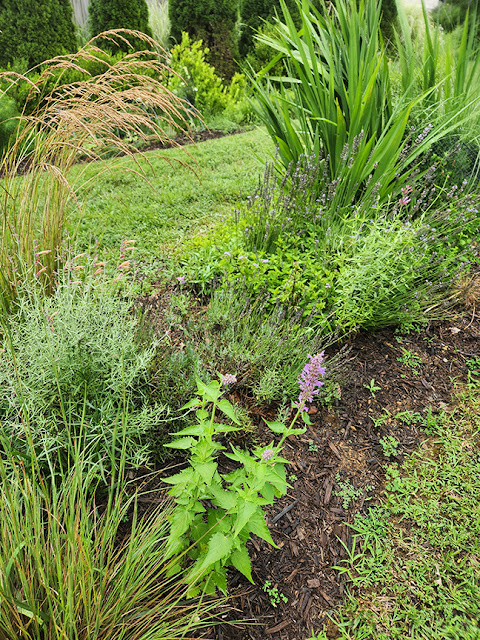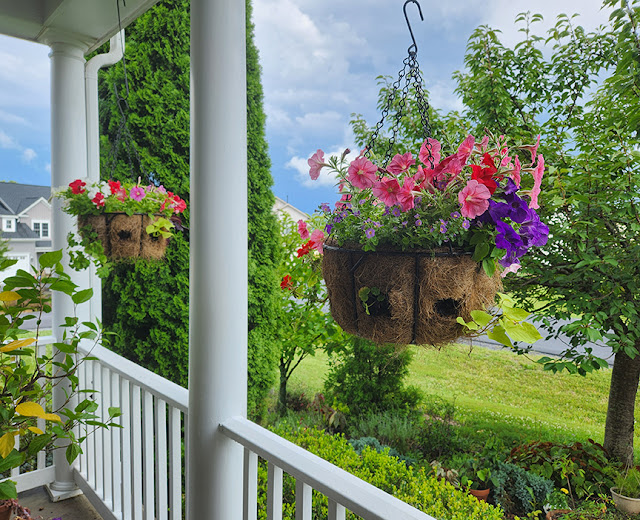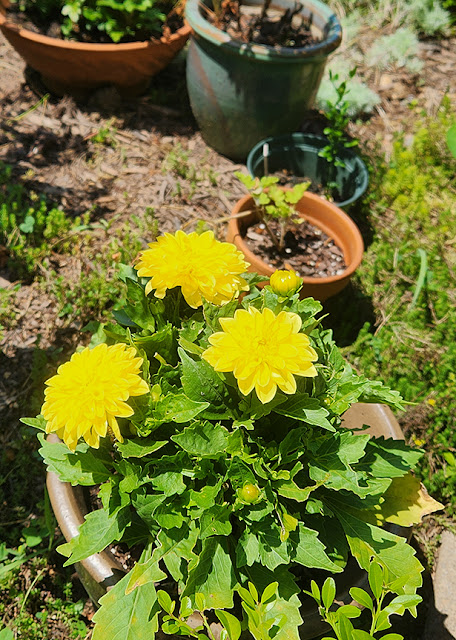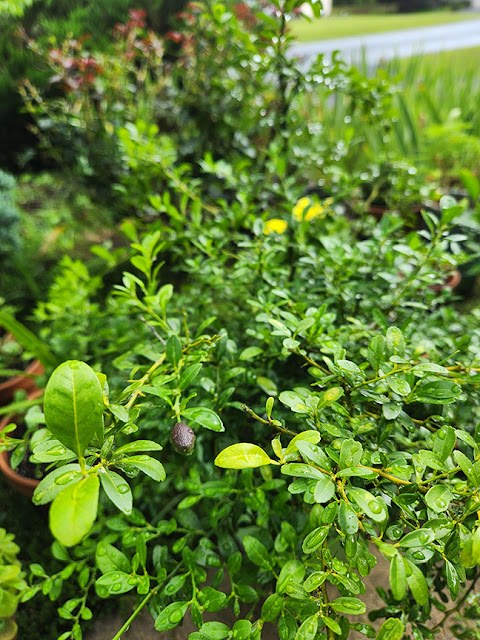 |
| Salvia 'Amistad' |
It's been such a busy week for me with my Botanical Art Intensive class at Blandy this past weekend, that I had barely any time to even look at my garden. Today I finally get to catch up and take a look at what's blooming. The strange effect of a breeze blowing across the Salvia 'Amistad' created this unusual iridescent effect in my photograph--weird, but beautiful!
The dogwood is losing its colorful leaves, a few other leaves are turning and dropping, but our nighttime temperatures haven't been low enough to cause much change in the leaves yet. We're told that we won't be having a very colorful fall this year in our region due to the warmth. A few of the hickories in the back woods are turning gold, others brown.
 |
| Front garden |
And yet my collection of potted plants are still blooming, if not as profusely. My two Mandevillas haven't bloomed at all this summer--I can't figure out why, other that they've been in those pots for a few years, and may be too pot-bound.
 |
| Potted plants along the front walk. |
 |
| Pink Petunia |
A nice surprise was to see the Sternbergias I planted among the strawberries pop up-- their golden blossoms only last a few days--so short-lived! I want them to multiply, but I also bought ten more bulbs to plant nearby, as well as some Crocus speciosus (autumn-blooming crocus). My Colchicums are done flowering, they came up very early this year, and with the recent hot weather, didn't last long. My 'Waterlily' Colchicum hasn't come up at all. Wonder what happened to it--is it the drought?
 |
| Sternbergia lutea |
 |
| Sternbergia |
My small plant of Japanese Anemone 'Honorine Jobert' opened its first bud today, but it was caught in the nylon mesh that keeps the deer from devouring them--sadly, I cut it off when I tried to detach it to photograph--here it is fallen on the ground, surrounded by plantains. I'll move the barrier forward after the next rain to prevent this from happening and give the plant more room. I so envy the giant clumps of this flower in Blandy's courtyard, I wonder how many years it will take for mine to make a decent show?
 |
| Anemone 'Honorine Jobert' |
Among the late bloomers are Roselle (Hibiscus sabdariffa) that I grew from seed collected at the Museum of the Shenandoah Valley (MSV) last summer. The deer ate these earlier, so it took the plants longer to bloom, but they finally have. Like all hibiscus, the flowers only open for one day. I hope some will set seeds so I can grow this again next year. The two plants I have were the only ones that sprouted from those seeds.
 |
| Roselle flower (Hibiscus sabdariffa) |
 |
| Roselle plant. |
The Shasta Daisies have some blooms this year--behind the net enclosure, the deer didn't get them! There should be more soon, these tend to bloom very late.
 |
| Shasta daisies. |
The Muhly and other grasses are one of the highlights at this time of the year, along with the swamp sunflowers.
 |
| Herb's bed with Agastaches and grasses (Little Bluestem, Calamagrostis) |
 |
| Muhly grass 'Flamingo' |
 |
| Swamp sunflowers (Helianthus angustifolium) |
I love those airy wild asters blooming next to the Muhly grass! The beautyberries (Callicarpa dichotoma 'Early Amethyst') have acquired a gorgeous color that complements the yellowing foliage.
 |
| Beautyberries |
The deer have been munching the aromatic aster buds, I don't know if I'll have any flowers. They've been munching on the Chrysanthemums too, so mine don't look like much. The Abelia Panoramic Color' is still blooming.
 |
| Abelia 'Panoramic Color' |
The seedpods of the Ceanothus 'Gloire de Versailles' are as interesting as the flowers. Unfortunately, I seldom get to see them, as the deer eat the flowers back a lot. These are some they left me.
 |
| Flowers and seedpods of Ceanothus 'Gloire de Versailles' |
There's still some Indian summer weather left before out first frost cuts everything down. I wonder what else may be in store for my garden?



























